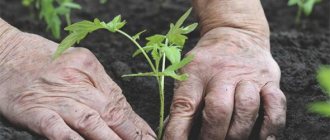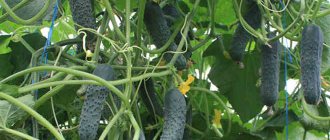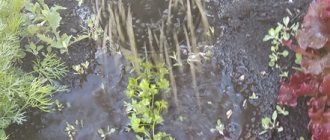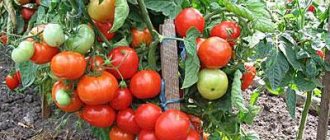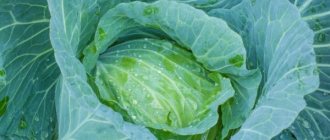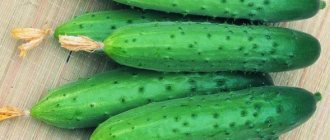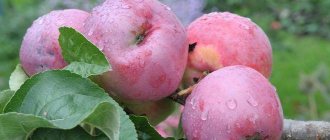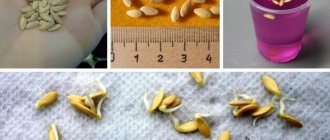Planting tomato Honey Spas
It is recommended to grow using the seedling method. Seeds for seedlings are sown 50-60 days before transplanting the sprouts to a permanent place. Since tomatoes are planted on a plot in early May (from the 1st), you can sow seeds for seedlings from the beginning of March.
It is recommended to grow Honey Spas using the seedling method.
The first step is to find a suitable box for seedlings. You can choose any medium height, the main thing is that there are holes at the bottom for water drainage. The soil chosen is soft and loose. It is poured into a box and poured boiling water over it. After a couple of days, you can sow the seeds. If branded seeds are purchased, they are not processed. If the seeds are from grown tomatoes or the market, they need to be kept in a weak solution of potassium permanganate, and then rinsed and dried.
Important! If the seedlings have a thin, weak stem, the tomatoes will not be able to produce a bountiful harvest.
Sowing is carried out to a depth of 1.5 cm. After sowing, the soil must be sprayed with water from a spray bottle, cover the box with film and place in a sunny place. After about 7 days, the first shoots can be observed. When they appear, the film must be removed. The box should be in a warm, sunny place
It is important to rotate it regularly so that sunlight hits all the sprouts evenly.
When 4-5 leaves appear, you can pick them in separate cups. This is an important procedure. It not only allows you to improve the soil in which tomatoes grow, giving the sprouts more free space, but also prevents diseases, since in separate pots the sprouts will no longer grow in crowded conditions, and fungal diseases will not be dangerous to them.
When the soil in the greenhouse or open ground warms up, you can plant the seedlings in a permanent place
2-3 weeks before transplanting the seedlings to a permanent place, it is necessary to begin hardening the sprouts. In the first days, the seedlings are taken outside for 30-40 minutes, then the time is gradually increased to 1-2 hours. When the soil in the greenhouse or open ground warms up, night frosts will no longer be observed, you can plant the seedlings in a permanent place.
Plant the sprouts in separate holes located at a distance of 50 cm from each other on average. Planting is carried out in fertilized, dug and loosened soil, and then watered. You can mulch the ground with straw or peat after planting.
Planting seedlings in a permanent place
This moment is determined by two factors:
- the air and soil in the open air should warm up steadily;
- 60 days must pass from the moment of sowing the seeds.
Typically this time in different regions falls in mid-May to early June. For beds that are being prepared in the fall, elevated places are chosen, protected from the active movement of air masses.
- The best predecessors of tomatoes are:
- cucumbers;
- beet;
- carrot;
- cabbage;
- onion;
- legumes.
- But it is highly not recommended to plant tomato seedlings on the soil after growing on it:
- eggplant;
- potatoes;
- tobacco;
- pepper
You should also not plant tomatoes after tomatoes until 3 years have passed. Plants must be planted in such a way that per 1 sq. m there were no more than three of them. In this case, the depth of the holes, pre-treated with a weak manganese solution and enriched with two spoons of potassium and phosphorus fertilizers, is determined by the need to deepen the earthen ball with the root system to such an extent that the soil poured on top of it reaches the lower leaves of the seedlings. Tomatoes transplanted to a permanent location require immediate watering with warm water.
Advantages and disadvantages of the variety
Over the decade of cultivation of the variety, gardeners managed to study it well and identified its advantages and disadvantages.
Pros:
- Unpretentious, persistent variety. Feels good in all regions of the country.
- High yield.
- In warm climates it grows well in open ground.
- Unusual sweet and sour taste.
- Non-hybrid plant - seeds can be collected from the harvest for the next planting.
- They decorate salads decoratively and add an impressive taste.
- Tomatoes ripen indoors, and new fruits may form on the bushes at this time.
- Long-term fruiting.
- Well stored and transported.
- Hypoallergenic (suitable for feeding children).
- Resistant to diseases.
- The period of fruit harvesting is before the cold weather.
- The plant can withstand sudden changes in temperature.
Minuses:
- Cannot be preserved.
- It is difficult to collect the seeds (there are few of them, and the pulp is fleshy).
- At high or low temperatures (below fifteen and above thirty-five), ovaries form poorly.
- Constant gartering and shaping of the plant takes time.
- Does not recognize acidic soils and requires proper care.
- In rainy weather the roots may rot.
- In risk areas, you need to plant in greenhouses - tomatoes take a long time to ripen.
It is easy to see that there are enough points in both lists above. Gardeners should carefully study the described variety before cultivating it.
Variety "Amber Cup"
A mid-early variety, it bears fruit 105–110 days after germination. Suitable for both greenhouses and open ground. The bushes are indeterminate, reaching a height of 1.7 m. The cluster is formed by four to five fruits.
Tomatoes are oval-shaped, with smooth skin, dense pulp, weighing 85-125 g. The pulp of these tomatoes contains a lot of carotene and dry matter, sweet in taste, with a lot of juice.
These tomatoes do not deteriorate during transportation, and are also able to maintain their appearance and taste for 2 months after harvest.
Bushes and fruits can easily withstand high temperatures and are not affected by tobacco mosaic virus, verticillium and fusarium. Ideal for raw consumption and canning.
Planting seedlings should be done 60 - 70 days before the intended planting in the ground. Picking is required when one or two leaves appear. Planting scheme – 3 – 4 seedlings per 1 sq.m.
Caring for seedlings should consist of regular watering with a small amount of warm water, as well as applying fertilizer from time to time.
The variety is unpretentious. The bushes will need regular watering, removal of lateral shoots, except one, so that a bush with two stems can be formed, weed removal, mulching, fertilizing, and garter. All time frames and volumes of care elements are similar to the standards.
Decide in advance on the type of bush formation
Characteristics and description of the variety:
| Tomato | |
| general characteristics | Mid-season |
| Maturation period | 110-115 days after germination |
| Keeping quality (safety in storage) | Low |
| Purpose | Salad, canning (for processing into juices and sauces) |
| Fruit weight | 160-220g |
| Number of fruits per cluster | 4-5 |
| Disease resistance | High |
- Bred by enthusiastic breeder from Novosibirsk V.N. Dederko. Included in the State Register in 2006 and approved for cultivation throughout the country. Recommended for growing on private plots and summer cottages and can be planted both in open ground and under film covers, and in greenhouses.
- Plants are indeterminate, non-standard. In open ground, the height is usually from 150 to 170 cm; in closed ground, bushes often grow to 2 m or even more. The stems are of medium thickness, the plants are quite compact, the first fruit cluster is formed after 8 leaves, then they are formed on average after 2 leaves. In total, up to 5 inflorescences grow, each ripening on average 4 tomatoes.
- You can form a bush into one or two stems. You need to decide on this aspect in advance, since if it is planted in one stem, then there are 4 plants per square meter, and if in two, then no more than three. Based on experience, they can say that when formed into one stem, tomatoes grow larger, and if there are two stems, then the number of fruits is greater.
- The fruits are most often round, sometimes narrowed at the bottom. But large tomatoes are often kidney-shaped or irregularly shaped with ribbed, uneven protrusions. The average weight is from 160 to 220 g, but fruits often grow 400-600 g, and some gardeners received options weighing more than 800 g. The color is rich yellow or light orange.
- This is a medium-ripening variety; on average, 110-115 days pass from the moment of germination to the harvesting of the first tomatoes. The period may be slightly shortened or increased depending on external conditions. Fruiting lasts a long time; at favorable temperatures, tomatoes are harvested almost until frost. They should be removed on time.
- From 2 to 5 kg is collected from one bush. It all depends on the place of cultivation - in greenhouses the yield is much higher, and compliance with agricultural technology. Compared to other options, the performance is average, but this variety is grown for its taste, not for its fertility.
- Resistance to adverse weather conditions is good. Plants set fruit well even in hot weather and tolerate nighttime drops in temperature well. Thanks to their thick skin, tomatoes almost never crack, although during periods of prolonged rain, cracks do appear in the area of the stalk.
- The taste is excellent. The pulp is very fleshy and juicy, with high sugar content, there are no voids and few seeds, it has a very strong aroma. Fresh tomatoes are especially good; they are ideal for baby food. The fruit also makes excellent juice and puree.
- Transportability and keeping quality are average. Fully ripe fruits are easily damaged and wrinkled, but if you pick them up a little unripe, they withstand transportation much better.
- Resistance to the tobacco mosaic virus and fairly high resistance to late blight are noted. But tomatoes are often affected by cladosporiosis and blossom end rot, so preventative treatments are desirable.
Variety "Persimmon"
The result of the work of amateur breeders.
The variety is mid-early, from the first shoots to the first harvest it takes an average of 115 - 125 days. The bushes are determinate, powerful, with a large number of leaves, grow up to 1 m in open ground and up to 1.5 m in a greenhouse. These bushes are recommended to be grown in greenhouses, but they also take root outdoors. The leaves are large, light green.
The fruits are round, slightly flattened on top, and quite large (the weight of the first fruits reaches 0.3 kg, while the rest gain no more than 150 g). Sometimes tomatoes grow that weigh more than 0.6 kg.
The color of the peel and pulp is orange; a bright green spot forms on top, near the stalk. The tomatoes themselves taste sweet, there are few seeds in the pulp, as well as juice. One of the disadvantages of this variety is that the taste of the fruit greatly changes when overripe. In this case, the pulp becomes fresh.
Also, the fruits have a hard peel, which does not improve the taste. But these tomatoes can withstand transportation well. Will not deteriorate when stored in a dark, cool place.
The yield averages 3.5 kg per plant. These tomatoes have a low amount of organic acids and a lot of carotene, so they can be considered an absolutely dietary product. They make good salads, and tomatoes are suitable for canning.
It is best to plant seeds between the end of March and the beginning of April. There must be picking and proper care of the seedlings. Transplantation can be carried out from mid-May in a greenhouse, and from the beginning of June - in open ground. The planting pattern is ordinary - 50x40-40 cm. No more than 3 seedlings can be placed per unit area.
It is imperative to carry out regular pinching of the bushes so that there is only one stem at the bottom. Due to their impressive height, the plants also need to be staked to make the growth process easier for the bushes and the harvesting process for yourself.
When pinching, it is advisable to remove the leaves that create shade for the fruit. Otherwise, sunlight will not reach the tomatoes and they will not ripen. Treatment with drugs and fertilizing with fertilizer complexes are required. Watering must be timely and without interruption.
Pests and diseases
It is better to prevent diseases than to treat them. Therefore, it is necessary to create certain conditions so that the plants do not get sick (especially since the variety is very resistant to diseases):
you need to monitor watering - avoid excess dampness and stagnant moisture; it is important to plant tomatoes in a timely manner - so that there is no shading, the branches are well ventilated; Remove dry leaves regularly. If the first signs of disease appear or traces of pests become noticeable on tomato leaves, you need to immediately treat all plants (even healthy ones) with an appropriate preparation
Preparations can be picked up at any gardening store.
If the first signs of disease appear or traces of pests become noticeable on tomato leaves, you need to immediately treat all plants (even healthy ones) with an appropriate preparation. Preparations can be picked up at any gardening store.
It is interesting to read the reviews of those who have already planted this variety. Here are some impressions:
Elena
I’ve been planting these tomatoes in a greenhouse for several years, I really like them, they’re really sweet, really honey-like, juicy! In cross-section they are unusual, reminiscent of an outlandish fruit. The bushes are very tall and require frequent staking. The yield is low, but the taste characteristics cover all the shortcomings!
N. N. Korkin
I would like to plant interesting varieties. Planted "Honey Spas". It’s now fun in the greenhouse - you can immediately see which tomatoes are ripe and which are not. The tomatoes taste good. They say they are not canned. My wife makes wonderful tomato juice from tomatoes - it stores well and tastes good.
Osipenko Alla
Honey saved tomatoes are powerful, strong, when you plant them, tie them up right away. I have 5 bushes in the greenhouse - seven are fed with salads all summer.
Lyudmila, Kharkov
This is my favorite - fruitful, delicious, honey-sweet. I form it into 3 trunks and collect the seeds. It lies well and settles down.
Olga
I liked the taste of the tomatoes, but, unfortunately, my tomatoes became ill with cladosporiasis.
V. N. Troshkin.
The variety is elegant, reliable, and productive. The bush is powerful, the leaves are large, the flesh is dense, honey-like. I recommend.
Alyona
Characteristics
Like any variety of tomatoes, Honey Spas has its advantages and disadvantages. Let's look into them.
Advantages
- According to the description, the variety is productive and in demand among gardeners, despite the fact that the fruits are not suitable for canning due to their large size and low acid content. But you can prepare salads from fresh tomatoes and prepare aromatic juice for the winter.
- The ripening cycle is extended; the harvest can be harvested until the end of the warm season, which is also convenient. Tomatoes Honey Spas, picked at blanche ripeness, are perfectly ripened indoors. Keep the picked fruits in a warm and dark place to prevent the sugar content from decreasing.
- Tomatoes of this variety can sit for several months without losing their beneficial qualities and presentation. Transportability is excellent, but gardeners who leave reviews about the Honey Spas variety advise picking unripe tomatoes for such purposes. Then they will reach the consumer in the required condition.
- Tomato juice of this variety is medically called purified water and the fruits are recommended for dietary and baby food. The benefits of yellow tomatoes can hardly be overestimated, but the most important thing, perhaps, is the absence of substances that cause allergies. It is useful to consume tomatoes for gastrointestinal diseases, as well as for people with kidney and liver problems.
- Abroad, tomatoes with yellow and orange fruits have a special attitude. It is believed that with regular consumption of tomatoes of this color, including the variety described, you can delay the onset of old age. It is not for nothing that residents of the Mediterranean coast call Honey Spas tomatoes a golden apple.
- Tomatoes can be grown in open and protected ground. In southern regions, they produce an excellent harvest outdoors because they are able to adapt to unfavorable conditions, including extreme heat or slightly lower temperatures. But in the risky farming zone, it is preferable to grow tomatoes of the Honey Spas variety under film. After all, the harvest (see photo below) in the greenhouse will be much greater than in open ground.
- Since this is a variety and not a hybrid, you can get your own tomato seeds. Although, as stated in the description, there are not many of them.
- Gardeners like the Honey Spas tomato variety for its special resistance to diseases of nightshade crops: late blight, gray rot, tobacco mosaic.
Flaws
Despite the obvious advantages, this variety also has disadvantages:
- The fruits of this variety of tomatoes set best at a temperature of +20-25 degrees. If the temperature is below +15 degrees or rises above +35, then barren flowers may appear due to the sterility of the pollen. Experienced gardeners shake tomato bushes in open ground or a greenhouse for better fertilization.
- Some gardeners in reviews cite the inability to preserve fruits for the winter as a disadvantage.
Tomatoes with yellow fruits:
Unusual tomatoes: green, orange, yellow
Tomato is one of the most popular and beloved crops, which can be found in almost every garden. Despite this, we don’t know much about its unusual varieties. It's time to get to know some of them better. Today we will discuss green, orange and yellow tomatoes.
We have already talked about original tomatoes in the first article of the series - Unusual varieties of tomatoes - white-fruited and black-fruited. It's time to discuss, perhaps not so exotic, but no less interesting varieties.
Green-fruited tomato varieties
emerald apple
Mid-season variety110-120 days
The plants are medium-sized (reach 1.2-1.5 m in height), powerful, spreading and well-leafed. They produce slightly ribbed, flat-round fruits weighing up to 250-350 grams, which when ripe acquire a bright emerald color with a lemon tint. However, tomatoes of this variety are extraordinary not only in appearance: their juicy and sweet emerald-lemon flesh tastes very much like ripe kiwi.
Swamp
Indeterminate variety for 95 days
The fruits are flat-round, ribbed, and green until ripe with a small dark spot at the base. Mature ones are bright green with light yellow and even pink splashes, weighing about 150-250 grams.
Green Cherokee
Medium-sized variety
Orange tomatoes
Orange tomatoes not only have a bright appearance, but also excellent taste. The thing is that they contain significantly more sugar than their red counterparts, which gives them a rich and delicate taste. In addition, orange fruits contain higher amounts of lycopene and beta-carotene, so they are considered medicinal.
Orange elephant
Mid-early determinate variety
Ripe bright orange fruits of round shape weigh about 250-300 grams. The pulp contains a lot of carotene, is very tender, and has a pleasant sweetish taste.
Persimmon
mid-season determinate variety
Large-fruited (up to 300 grams) tomatoes of this variety are distinguished by their bright orange color, the same as that of ripe persimmons. That's why they got their name.
Yellow tomatoes
vitamins, carotenoids, lycopene
The most popular varieties of yellow tomatoes are:
Determinate variety
The pulp of the fruit is very juicy and fleshy, and their weight reaches 200-400 grams.
Honey saved
mid-season indeterminate variety
Sometimes these honey-yellow fruits can weigh 500 or even 600 grams. The variety is very heat-resistant and extremely tolerant to unfavorable growing conditions.
Honey drop
Mid-early variety
Small bright yellow fruits weigh about 30 grams. Very sweet. But their peculiarity is not only their amazing taste: they are absolutely not susceptible to diseases such as blackleg and late blight, which makes them even more valuable.
Ray
early ripening
The fruits are distinguished not only by their pronounced sweetish taste, but also, dare I say it, by their record carotene content: 5 times more than in ordinary red tomatoes. The variety is moderately resistant to major diseases.
Mid-season variety
The variety itself is very productive and extremely resistant to unfavorable growing conditions.
gold fish
early ripeningdeterminate
Cylindrical, very smooth fruits, reaching technical ripeness, acquire a yellow-orange color. Their weight reaches 90 grams. The variety is resistant to major tomato diseases and is slightly susceptible to late blight.
What unusually colored tomatoes grow in your summer cottage - green, yellow or orange? What did you like about them or, conversely, did you not like?
7dach.ru
- Tomato varieties in open ground
- Diseases of tomato seedlings
- Planting tomatoes in a greenhouse
- Picking tomato seedlings
- Growing tomatoes in open ground
- Early tomatoes
- When to plant tomatoes in Siberia
- Growing tomato varieties
- Varieties of tomatoes for the balcony
- How long are tomato seeds soaked?
- What varieties of tomatoes are the most productive?
- Growing tomato seedlings
- Tomato seed treatment before sowing
- How often to water tomatoes in greenhouses
- How to plant tomato seedlings correctly
- Caterpillar on tomatoes
Description
Tomato Honey Spas is a young variety created by Russian breeders from Novosibirsk. Head - V. N. Dederko. The culture was recorded in the State Register of the Russian Federation in 2004. A new variety is recommended for cultivation in any region of Russia in open ground and greenhouses.
Gardeners in their reviews note that the Honey Spas tomato, in terms of the characteristics and description of the variety, completely coincides with the properties declared by the breeders.
Let's look at the description in detail.
Bush
The Honey Spas tomato is an indeterminate tall plant. Gardeners are happy to grow productive tomatoes, despite the fact that this salad variety has to adjust the height of the stem throughout the growing season. The Honey Spas variety must be tied to a support.
In addition, in areas of risky farming, it should only be planted in a greenhouse due to the long period of fruit ripening. The first tomatoes are harvested 110-115 days after germination.
Tomatoes of this variety are powerful, about 130-175 cm high, with medium foliage. The leaves on tomatoes are light green. Honey Spas tomatoes are grown with 1-2 stems, maximum three.
Important! To get a decent harvest of tasty fruits, you need to plant 2-3 plants per square meter. Tomatoes are powerful because they have a well-developed root system.
The roots obtain food not only at the surface: the central root goes to great depths
Tomatoes are powerful because they have a well-developed root system. The roots obtain food not only at the surface: the central root goes to great depths.
Fruit
The tomatoes are glossy, with thick skin, and do not crack when ripe. According to gardeners, the shape of tomatoes, even on the same bush, is different. Some look like a heart or kidney, others, on the contrary, are round or slightly flattened. Look at the photo, here they are tomato varieties in all their glory.
The fruits of tomatoes of the Honey Spas variety are large, weighing up to 200 grams per one. There are also record holders, growing up to 500-600 grams with excellent agricultural technology. It is impossible not to notice tomatoes during the ripening period, since they have an unforgettable and incomparable warm orange-honey or bright yellow color.
According to the description of the variety, Honey Spas tomatoes are dense, juicy, fleshy, and sugary when cut. There are few seeds, they are small.
According to reviews from gardeners and fans of the variety, the consistency is a little oily. The amount of sugar is large, but the acid is low, so tomatoes are not suitable for canning.
The tomatoes taste sweet with a pleasant honey aroma and do not crack.
Description of tomato variety Honey Spas with photo
The tomato belongs to the indeterminate type. The plant is tall and therefore requires regular shaping and pruning. The bush is powerful and needs support. Its height reaches 130-175 cm. The inflorescences are simple.
Foliage is medium, leaf blades are light green in color, ordinary
The shrub has a powerful root system, the main root goes deep into the ground.
Description of fruits
Tomatoes have thick, glossy skin. They are varied in shape: some fruits are round, others look like a heart or a kidney. The formation of tomatoes flattened on both sides is possible.
The fruits are large, the average weight of each is 200 g. With proper care and a favorable climate, specimens weighing 500-600 g can be found. The color of Honey Spa tomatoes is memorable; unripe tomatoes are green, but as they ripen they become orange-honey in color. There are also specimens with a pinkish-orange color.
Tomatoes are not only dense, but also very juicy, fleshy, with a small number of seeds
When cut, the fruit pulp appears sugary. They taste sweet, with a small amount of acid, slightly oily. A characteristic feature of the variety is its pronounced honey aroma.
Harvesting and processing
Tomatoes of the Honey Spas variety are harvested as they ripen. Whole fruits can be stored for about 2 weeks or more in the refrigerator. But if they are cracked, they will quickly begin to rot. So it is better to immediately put them into recycling.
Tomatoes of the Honey Spas variety are harvested as they ripen.
The Honey Spas tomato is used mainly for fresh consumption. The fruits can also be used to make sauces and tomato juice.
Important!
Tomatoes of the Honey Spas variety are not suitable for sourdough or fresh canning. They are quite large, and the thin skin quickly bursts during pickling and when stored in such preservation, the fruits quickly lose their shape.
Planting a tomato
Initially, seedlings are grown at home, which are transplanted into open ground or a greenhouse in May. To obtain strong and healthy seedlings, planting material is correctly selected and prepared.
Preparing and sowing seeds
Before planting, the seeds must be properly prepared, for which the following steps are performed:
- calibration to eliminate damaged, rotten or defective seeds;
- soaking in a saline solution, in which empty specimens rise, and full-fledged grains remain at the bottom;
- washing the remaining seed in clean water;
- treatment with a solution of potassium permanganate for 20 minutes;
- drying seeds;
- soaking in a growth stimulator;
- placing the material in gauze, which is constantly wetted and transferred to a warm place until the seedlings peck.
Sowing begins 2 months before transplanting into open ground. For this, plastic containers or other containers are prepared, filled with humus with sand and peat, and all ingredients are mixed in equal proportions. Small grooves are made in the resulting mixture, which are watered, and then the seeds are placed to a depth of 2 cm. A distance of 5 cm is maintained between the grains. They are covered with soil on top.
The first shoots appear in about a week. Young plants need even watering, high temperatures and good lighting. The containers are placed in a window where there are no drafts. The temperature is maintained from +20 to +24 degrees. Periodically, the sprouts have to be loosened, and watering is carried out only at the root. A spray bottle is used to increase humidity.
Germination and picking
Growing seedlings need feeding 2 weeks after the first shoots appear. For this purpose, liquid fertilizers intended for vegetables are used.
Picking is done after four leaves appear. For this, ordinary plastic cups or special containers for seedlings are used, in which there are many separate sections.
Tomato care
Two months after the appearance of the first shoots, the seedlings are transplanted into open ground. The procedure is performed in the second half of May. Plants are planted in the soil in the evening in warm and calm weather.
Attention! The soil is first watered with water, holes are made in it, the depth of which is about 35 cm. A little wood ash and superphosphate are placed in each hole
A little wood ash and superphosphate is placed in each hole.
Watering and fertilizing
Caring for plants does not require significant effort:
- tomatoes are watered with settled and warm water;
- watering is carried out at the roots of plants;
- one bush requires from 5 to 8 liters of water per day;
- once every two weeks, the lower leaves and stepsons are removed;
- The soil is regularly loosened and weeds are removed;
- Fertilizers are applied once every 2 weeks, alternating root and foliar fertilizers;
- combined products, organics or herbal infusions are used.
Bush formation
The “Honey Spas” variety is distinguished by its significant height, so regular garter is required, and from the very beginning after transplanting the seedlings into open ground. For this, trellises or wood stakes are used. If more than 5 fruits of significant size are formed on the hands, then additional supports are needed. This is necessary to protect the brushes from breakage and provide access to the sun's rays to the fruit.
Bushes with 2 or 3 stems are formed, and the side shoots are completely removed. Otherwise, you end up with numerous bunches of small tomatoes.
Disease and pest control
It is advisable to prevent diseases of vegetables, since many diseases cannot be cured. Therefore, optimal conditions for growth are provided:
- the occurrence of high humidity and dampness is prevented, therefore an optimal watering regime is required;
- timely pinching allows you to remove excess shoots that shade the fruits;
- dry leaves are removed;
- If the first signs of disease or pest exposure occur, treatment is promptly carried out, and not only infected bushes are treated with drugs, but also neighboring bushes.
The most common diseases include late blight, mosaic, bacterial wilt, macrosporiosis and chloratic leaf curl. To combat pests such as slugs, aphids or the Colorado potato beetle, folk remedies are used. To do this, all bushes are sprayed with a solution of laundry soap or iodine.
Growing and care
Tomatoes of the Honey Spas variety are propagated by seedlings. The timing of sowing seeds is easy to calculate, because they depend on the time of planting the plants in a permanent place. Tomato seedlings are considered mature when they are 50 or 60 days old. Seedlings should be thick-legged and stocky, with leaves evenly spaced.
Comment! Tomatoes that are elongated and have a thin stem will produce a smaller yield.
Seedling
- Tomatoes already at the seedling level need fertile soil. You can use ready-made soil or prepare it yourself. In any case, the soil needs to be disinfected for two days before sowing the seeds. To do this, the soil is heated on a stove or poured with boiling water with the addition of potassium permanganate. It is necessary to disinfect not only the soil, but also the planting containers.
- Tomato seeds are also prepared for sowing. As a rule, this is the end of March or the beginning of April. First, the seeds are placed in salt water to select the good material (unripe seeds will float to the surface). After this, the seed is washed in clean water and soaked in a pink solution of manganese or boric acid. The seeds are washed again and dried to a powdery state.
- Growing tomato seedlings of this variety can be done with or without picking. If you are not a fan of planting seedlings, then the seeds should be germinated and sown in separate pots, 1-2 seeds each. After the tomatoes have grown, the strongest seedling is selected and the second one is removed.
- The seeds need to be planted to a depth of no more than 1 cm. Then the container is covered with film so that the tomato seedlings appear faster; they are put away in a warm and bright place. After the first hook appears (and this happens after 4-5 days), the film is removed and the temperature is slightly reduced.
- In the phase of 2-3 true leaves, tomato seedlings of the Honey Spas variety are picked. When replanting, the plants are buried down to the cotyledon leaves, watered well and removed for 2 days in partial shade.
You can determine that tomatoes have taken root by the turgor of the leaves: they become elastic, and their color corresponds to the variety.
- Water the seedlings without waiting for the top layer of soil to dry, but you shouldn’t overwater them either. If you are not a fan of mineral fertilizers, you can feed the Honey Spas tomatoes with an infusion of wood ash.
Care in the ground
Seedlings are planted in open ground or a greenhouse when night temperatures no longer drop below 15 degrees. The soil is prepared in advance: humus, compost or mineral fertilizers are added. Wood ash is one of the required components. It contains many micro- and macroelements necessary for tomatoes.
Comment! When transplanting, tomatoes must be immediately tied to a strong support, and then the bunches with fruits are subjected to the same procedure.
The lower leaves, and then those that grow above the formed brush, are gradually removed. This will ensure air circulation and sufficient lighting. Stepchildren are also removed, forming a bush with 1-2 or, in extreme cases, 3 stems.
The bushes need to be watered abundantly, no more than 2 times a week. It is advisable to combine fertilizing with watering. For good fertilization of the ovaries, tomato variety Honey Spas, as gardeners write in reviews, is sprayed with a solution of boric acid. This is an excellent foliar feeding.
Tomatoes really like an infusion of mullein or freshly cut grass (without seeds!); they respond to such fertilizing with an excellent harvest. You can dust tomatoes and the soil around them with wood ash from time to time: both nutrition and protection from disease.
And, of course, prevention of fungal and viral diseases, despite the fact that according to the description the variety is resistant to them. Chemical preparations for spraying are undesirable. It is better to hang tea bags soaked in iodine in the greenhouse or spray the plantings by dissolving 1 tablespoon of iodine in a bucket.
Advice! If there is an unripe area left on the stalk, then water the Honey Spas tomatoes with an extract of wood ash.
Tomatoes are harvested as they ripen. But so that the fruits do not slow down their growth, it is advisable to pick them at ripeness.
Diseases and pests
Excellent immunity protects plants from diseases such as late blight, gray mold, tobacco mosaic and other viral and fungal diseases. However, when grown in greenhouses or unprotected soil, infection from other tomato varieties can occur. Preventive actions:
- Spraying plantings with “Fitosporin” or other non-toxic biological products;
- Tomato bushes suffer from attacks by naked slugs, cutworms, Colorado potato beetles, aphids and whiteflies. In the fight against flying pests and slugs, it is effective to regularly spray the plantings with an aqueous solution of ammonia. You can destroy the larvae of parasites by watering the soil with a solution of copper sulfate or potassium permanganate. Aphids are washed off using a soap solution, which is used to treat the affected plants.
Review from a gardener:
Characteristics of tomatoes
"Honey Saved" —
mid-season, salad variety. Due to the low acid content, the fruits are not suitable for preservation, but this same quality makes them useful for people with problems with the gastrointestinal tract. Tomatoes have a mild sweetish taste, with a subtle hint of acid.
The yield is encouraging: from a square meter to 14 kg when grown in greenhouse conditions, on open ground —
half as much. The fruits have an excellent presentation, they tolerate transportation well and are stored for a long time.
The variety is resistant to changes in weather conditions (frost, heat), and is immune to fungal diseases. The extended ripening period allows you to enjoy tomatoes all summer, and the last harvest can be harvested at the stage of technical maturity; it ripens perfectly even in apartment conditions.
Did you know? The tomato
is one of the most popular vegetables in the United States and is officially recognized as the state vegetable of New Jersey.
How to grow tomatoes
Honey spas is grown anywhere - both in a greenhouse and in the open air. The main thing when landing is to follow all the rules.
Landing
A windless, cloudy day is ideal for planting Honey Spas in open ground. The bushes should be 10-12 cm apart from each other. The future plant needs a lot of light - otherwise it will get sick.
After planting the sprouts, water the beds generously with warm water. Direct the stream of water directly at the root - and in no case at the stem and leaves themselves.
Do not forget to remove weeds in time, otherwise they will take nutrients from the tomatoes. Since the bush is tall, a mandatory garter is required. Monitor the formation of stepchildren - every week it is recommended to remove all excess.
It is best to do this with your hands - this reduces the likelihood of damaging the stems. Tomatoes require loosening of the soil - thanks to it, the soil will be airy and enriched with the necessary amount of oxygen.
As for fertilizing, here too you have the right to choose:
- Use natural remedies. For example, treat the bushes with an ash-based solution. This simple recipe will protect the crop from possible ailments and increase the yield. Or you can use mixtures based on organic waste.
- Buy professional products. Nitrogen-containing fertilizers are in greatest demand. For example, potassium-phosphorus solution. To ensure the plant develops harmoniously, alternate mineral and natural fertilizers.
Features of cultivation and possible difficulties
Like any tomatoes, Honey Spas has its own growing nuances.
Among them, pay special attention to the following:
- the need to systematically fertilize the beds;
- mandatory tying of bushes;
- removal of stepsons.
All these measures are necessary to avoid pests and diseases. Plus, proper care is the key to an excellent harvest. Otherwise, the Honey Spas tomato is no different from other varieties.
Diseases and pests
Top 5 most common varieties diseases:
- Late blight is a fungal disease that penetrates the inside of the stem and destroys the plant. Characteristic signs of late blight are the appearance of brown spots and white coating on the leaves. It is best to fight the disease with professional means;
- tobacco mosaic - looks like a yellow pattern on the leaves. The cause of the disease may be an excess of nitrogen in fertilizing. If tobacco mosaic is detected, infected bushes should be removed;
- powdery mildew - white coating on bushes. As a rule, people become infected with it in early summer. Favorable conditions are hot, dry weather, which is accompanied by fluctuations in humidity and temperature. For the fight, it is recommended to use the drugs “Tilit”, “Skor”, “Topaz”;
- anthracnose This disease spreads both to the bushes and to the tomatoes themselves. Characteristic signs are the appearance of dark sunken spots on tomatoes. It is recommended to combat anthracnose with the help of “Quadris” and “Strobe”;
- aspermia. Because of this disease, the flowers of the bush grow together, the leaves become small and change color. Aspermia is transmitted through insect vectors.
Top 5 common pests:
- mole cricket - has a harmful effect on the roots of tomatoes, can live both in a greenhouse and in open ground. Ammonia or garlic cloves will help protect you from mole crickets - place them in the holes when planting;
- Whiteflies are small white insects that are dangerous pathogens. Whiteflies should be combated using an infusion of ash;
- Spider mites are another worst enemy of tomatoes. It eats the leaves of the plant, which disrupts metabolism and causes the bushes to die. It is recommended to treat the bushes with Aktara or Apollo;
- The wireworm damages the roots and stem - the bush turns yellow, dries out, and stops growing. The drug “Bazudin” is excellent for combating wireworms;
- sprout fly. It feeds on plant sprouts and seeds. An effective method of control is a tincture of tobacco leaves.
How to grow seedlings
To get a tasty harvest, pay special attention to preparing seedlings
Seed preparation
The market offers a huge number of seeds of the Honey Spas variety. Trust only reliable suppliers; if necessary, consult with familiar gardeners about the advantages or disadvantages of a particular manufacturer. It would be a good idea to read the detailed background information.
Before planting, seeds must be disinfected. This is done using a solution of potassium permanganate - it will remove all germs and infections. Next, it is recommended to harden the seeds - place them in the freezer for 10 hours, then remove them and leave them at room temperature for a day. Then place it in the freezer again, then in the room.
These simple steps will help avoid problems in the future - the plant will have excellent immunity to weather changes. This operation is especially useful for summer residents from central Russia and the northern regions.
Next comes the germination procedure - the seeds are wrapped in slightly damp gauze. There is no clear opinion on this matter - some claim that germination has a beneficial effect on yield, others consider it useless. Many gardeners are confident that the most resilient and productive plants are those grown from dry seeds.
Container and soil
There are no special criteria for choosing containers for seedlings, so both ordinary wooden boxes and special plastic containers are suitable. The main thing is that the container is clean and dry.
With soil, things are a little more complicated. If you wish, you can cook it yourself. This will require clean soil, humus, peat and ash (in a ratio of 3:1:1:1). You can add sand and sawdust to it - this will make the earth lighter and more air will flow into it. Another option is to purchase a ready-made mixture at the store. Ready-made substrates already contain all the necessary elements for the plant.
Important! If you make the mixture yourself, do not forget to disinfect the soil. After all, it contains the remnants of past fungi or parasite larvae
This should be done using the potassium permanganate solution mentioned above.
Sowing
The sowing procedure does not require special preparation or skills. Take a container, fill it with soil and make small holes, about 2 cm deep. Place the prepared seed in them, sprinkle some soil on top and water generously. Place the seedlings closer to light and warmth. If the house is dominated by shadow, then arrange additional lighting using fluorescent lamps.
